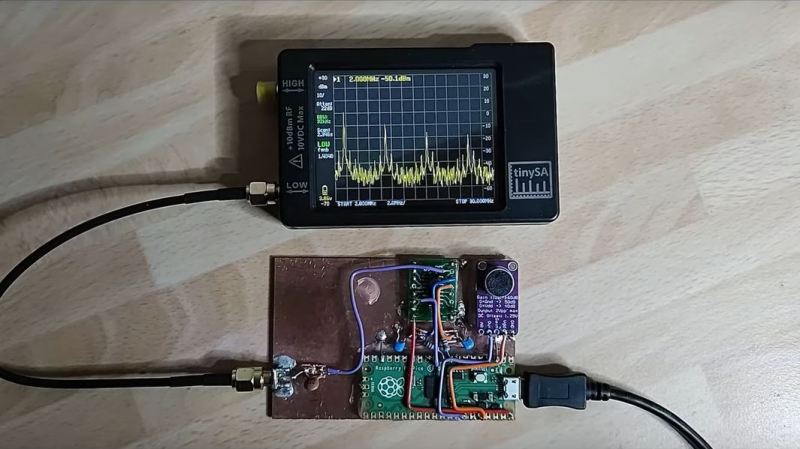There are plenty of hobbies around with huge price tags, and ham radio can certainly be one of them. Experienced hams might have radios that cost thousands of dollars, with huge, steerable antennas on masts that can be similarly priced. But there’s also a side to the hobby that throws all of this out of the window in favor of the simplest, lowest-cost radios and antennas that still can get the job done. Software-defined radio (SDR) turned this practice up to 11 as well, and this radio module uses almost nothing more than a microcontroller to get on the air.
The design uses the capabilities of the Raspberry Pi Pico to handle almost all of the radio’s capabilities. The RF oscillator is driven by one of the Pico’s programmable I/O (PIO) pins, which takes some load off of the processor. For AM and SSB, where amplitude needs to be controlled as well, a PWM signal is generated on another PIO which is then mixed with the RF oscillator using an analog multiplexer. The design also includes a microphone with a preamplifier which can be fed into a third PIO; alternatively it can receive audio from a computer via the USB interface. More processor resources are needed when generating phase-modulated signals like RF, but the Pico is still quite capable of doing all of these tasks without jitter larger than a clock cycle.
Of course this only outputs a signal with a few milliwatts of power, so for making any useful radio contacts with this circuit an amplifier is almost certainly needed. With the heavy lifting done by the Pico, though, the amplifier doesn’t need to be complicated or expensive. While the design is simple and low-cost, it’s not the simplest radio possible. This transmitter sends out radio waves using only a single transistor but you will be limited to Morse code only.

















Is it just me or deja vu?
Hahaha, I am working on receiving 40.68 MHz using a Pico and a single 1MΩ resistor plus piece of wire. So far, I am at about 5m range with another Pico transmitting using another piece of wire. It’s like solving a puzzle. :-)
Just a hint: use longer wires and let them connect ;)
:-D Haven’t though of that!
I believe that the wires not touching make for a fun-er challenge, though. Bonus points for dithering high frequencies to dampen TX harmonics to keep the MiB (and airplanes) away.
What have MibiBytes got to do with it?
An old ham-radio saying: The longer the antenna the closer to the receiving station.
a 70 inch piece of wire is about a quarterwave for that frequency
I am currently at 10+ meters inside my apartment (3+ dBm SNR) full of walls and obstacles with about 1.3m wires and about 10 kHz bandwidth. I am planning to design a better antenna as soon as I turn another Pico into a rudimentary scalar network analyzer.
Use the spacebar as the key for CW
I love that the ham radio hobby encourages such a massive diversity of self-promoted learning.
I’m working on a scratch built cw radio. Best case I end up with a working transmitter and/or receiver. But I’ve already self-taught, ahem, myself tons and even if I quit today I have a much greater understanding of basic electronics, circuit design, construction and theory and RF methods. So actually building the radio is a happy byproduct of the real goal.
Love this pico project and love amateur radio.
73 craig
This could also quite easily have been an article on QRP.
Yikes! Has anyone else noticed how dirty the output of the radio is in the picture?
Yeah, he talks about putting a filter on it in an upcoming video.
He literally acknowledge it and even shows how strong the 3rd harmonics is on VHF. And suggest a filter before using it on the air.
Has everyone missed the gem? https://101-things.readthedocs.io/en/latest/radio_receiver.html is a minimalist standalone sdr receiver using a PI Pico, OLED display, and rotary encoder. $5 BOM on aliexpress (should already be in most hobbyist’s junkbox), and the Tayloe detector.
Mr. Dawson, you should add a quick user guide about UI and menu’s
(Including Rx and guitar effector) !
I’m trying to replicate this but having a few issues. Is there a place where “101-things” projects are discussed? I raised an issue on GitHub and Jon addressed it but it’s not a great way to ask questions.
Good news! I wrote to Jon about my build issues and reliability and he has fixed them. If you have the code from when it appeared, do a git pull and try again.